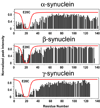Biophysical characterization of intrinsically disordered proteins
- PMID: 19162471
- PMCID: PMC2728036
- DOI: 10.1016/j.sbi.2008.12.004
Biophysical characterization of intrinsically disordered proteins
Abstract
The challenges associated with the structural characterization of disordered proteins have resulted in the application of a host of biophysical methods to such systems. NMR spectroscopy is perhaps the most readily suited technique for providing high-resolution structural information on disordered protein states in solution. Optical methods, solid state NMR, ESR and X-ray scattering can also provide valuable information regarding the ensemble of conformations sampled by disordered states. Finally, computational studies have begun to assume an increasingly important role in interpreting and extending the impact of experimental data obtained for such systems. This article discusses recent advances in the applications of these methods to intrinsically disordered proteins.
Conflict of interest statement
The author has no conflicts to declare.
Figures


References
-
- Ward JJ, Sodhi JS, McGuffin LJ, Buxton BF, Jones DT. Prediction and functional analysis of native disorder in proteins from the three kingdoms of life. J Mol Biol. 2004;337:635–645. - PubMed
-
- Oldfield CJ, Cheng Y, Cortese MS, Brown CJ, Uversky VN, Dunker AK. Comparing and combining predictors of mostly disordered proteins. Biochemistry. 2005;44:1989–2000. - PubMed
-
- Tompa P, Dosztanyi Z, Simon I. Prevalent structural disorder in E. coli and S. cerevisiae proteomes. J Proteome Res. 2006;5:1996–2000. - PubMed
-
- Dyson HJ, Wright PE. Intrinsically unstructured proteins and their functions. Nat Rev Mol Cell Biol. 2005;6:197–208. - PubMed
-
- Fink AL. Natively unfolded proteins. Curr Opin Struct Biol. 2005;15:35–41. - PubMed
Publication types
MeSH terms
Substances
Grants and funding
LinkOut - more resources
Full Text Sources
Other Literature Sources
Miscellaneous

